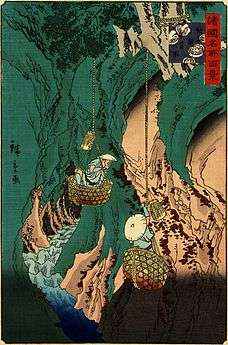Umbilicaria esculenta
| Umbilicaria esculenta | |
|---|---|
| Scientific classification | |
| Kingdom: | Fungi |
| Division: | Ascomycota |
| Class: | Lecanoromycetes |
| Order: | Lecanorales |
| Family: | Umbilicariaceae |
| Genus: | Umbilicaria |
| Species: | U. esculenta |
| Binomial name | |
| Umbilicaria esculenta (Miyoshi) Minks | |
Umbilicaria esculenta is a lichen of the genus Umbilicaria that grows on rocks, also known as rock tripe. It can be found in East Asia including in China, Japan, and Korea. It is edible when properly prepared and has been used as a food source and medicine. It is called iwatake (kanji: 岩茸 or 石茸) in Japanese and seogi (hangul: 석이; hanja: 石耳; literally "stone ear" or "rock ear") or seogi beoseot (hangul: 석이버섯; literally "stone ear mushroom") in Korean. The species name is based on the earlier basionym Gyrophora esculenta.
In vitro antiviral activity
Polysaccharides from the lichen have been shown to inhibit replication of the HIV virus in laboratory tests.[1]
References
- ↑ Hirabayashi K, Iwata S, Ito M, Shigeta S, Narui T, Mori T, et al. (1989). "Inhibitory effect of a lichen polysaccharide sulfate, GE-3-S, on the replication of human immunodeficiency virus (HIV) in vitro". Chem Pharm Bull. 37 (9): 2410–2. doi:10.1248/cpb.37.2410. PMID 2575016.
- Moo-Sung Kim; Hong-Bum Cho (December 2007). "Melanogenesis Inhibitory Effects of Methanolic Extracts of Umbilicaria esculenta and Usnea longissima" (PDF). 45 (6). The Journal of Microbiology: 578–582.
Gallery
 Iwatake gathering at Kumano in Kishū, by Hiroshige II
Iwatake gathering at Kumano in Kishū, by Hiroshige II Korean pan-fried Umbilicaria esculenta
Korean pan-fried Umbilicaria esculenta
External links
| Wikimedia Commons has media related to Umbilicaria esculenta. |
- Umbilicaria esculenta, at IndexFungorum.org
- ZipCodeZoo Zipcodezoo.com
- Gyrophora esculenta, at IndexFungorum.org
- Japanese drawings showing the harvesting of U. esculenta at Nifty.com
See also
This article is issued from
Wikipedia.
The text is licensed under Creative Commons - Attribution - Sharealike.
Additional terms may apply for the media files.